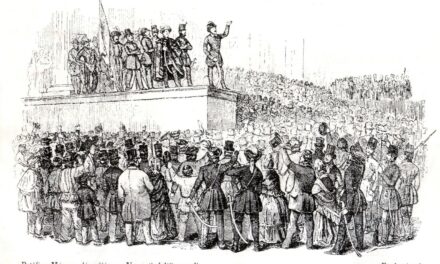Mathematical calculations confirm the unstoppable decline of the native French population and the growth of the immigrant population at a similar rate, which by 2070 will be roughly the same number of people living in France - former mayor and member of the National Assembly Pierre Albertini wrote about this in the conservative newspaper Le Figaro.
The professor emeritus of the University of Rouen addressed the discussion of the planned referendum on immigration in his article. The referendum strongly preoccupies the French public,
generating sharp social debate.
It is not kept on record
"Double anthropological break in French society" - the author, who previously taught constitutional law and legislation at the University of Rouen, already indicates in the title of his article that he does not belong to the ranks of intellectuals who celebrate the phenomenon of increasing immigration with a loud ovation.
Since 1980 alone, 29 laws with different powers have dealt with immigration in France, the article reveals. But according to Albertini
"this tinkering will remain ineffective until it is preceded by a debate based on figures and demographic projections,
which is essential for reason to triumph over passions”. The author would see a sense of responsibility as more appropriate than "posturing by the media."
Unlike the Scandinavian countries, which keep accurate records of their population trends,
France does not keep records of people entering or leaving the country
warns the former mayor.
Inaccurate measurement method
"We refuse to collect data that would allow us to take measures on the origin, distribution and integration of migrants. No one can give exact figures on illegal immigration"
he states.
According to Albertini, the number of immigrants is estimated using a rather imprecise method, which is simply identified with those receiving public health care support. This number in 2021 was 380,000 people. However, free movement within the European Union already makes this ratio relative.
The jurist also cites data from the French statistical institute INSEE for February 2022, according to which
By 2070, France could have 68 million inhabitants.
The "parameters" on which the survey is based are the following: the maintenance of the fertility rate of 1.8 children per woman, the increase in the number of deaths due to the continuous aging of the population, and "a positive migration balance of similar magnitude to the current one."
The problem of an aging society
The number of people over the age of 65 will be significantly higher (29 percent) than the number of people under the age of 20 (20 percent). The natural balance, which
measures the difference between births and deaths, it is already at its lowest level today (56,000 people in 2022) and will become negative from 2035, just over ten years from now
Albertni points out.
In half a century, only the surplus of immigration will make it possible to maintain the population, he notes, adding: because of this, France will "go through a double anthropological break", since
on the one hand, the natural replacement of the population will cease, and on the other hand, due to immigration, "in addition to the change in the age composition visible in the INSEE forecast, the geographical origin of the new arrivals will also cause significant changes in society."
In the absence of ethnic statistics, which only a few researchers deal with, how can we assess the current population structure and the effects of future migration flows? - asks the retired politician.
Some demographers are satisfied with the statement that the proportion of foreigners living in France is unchanged, but their analyzes deliberately underestimate the level of immigration, the author writes.
Immigrants are coming
"As the recent riots have painfully shown, a French identity card is not enough to make its holder a citizen with ties to our country"
Albertini underlines.
The article highlights: however, the surveys conducted by the INSEE and INED research institutes in 2008-2009 and 2019-2020 provide a fairly comprehensive basis for analysis. Using large samples, they show that
32 percent of the population under the age of 60, i.e. 16 million out of 50 million, have an immigrant background in whole or in part for three generations,
and that the geographic origin of immigrants has changed significantly: instead of the initial European one, we can now speak mainly of African migration.
If we accept these objective numbers, the "indigenous" or "ethnic" population with no immigrant ancestors from son to grandfather is about 46 million, while the population of wholly or partly immigrant origin is about 22 million, of which 60 percent comes from outside Europe, according to INSEE. This distribution will be significantly affected by the migration surplus, which
From 2035 onwards, it will be an essential and then exclusive source of demographic growth
says the professor.
The most recent partial censuses put this number at 16,000 to 18,000 people per year, he writes.
"However, if we take into account illegal arrivals, including unaccompanied minors, rejected asylum seekers remaining in France and French citizens leaving the country, the annual influx of foreigners will be higher, about 250,000 people, and the geographical origin of these people is also irrelevant. "
An unstoppably declining indigenous population
The main sources of immigration are now the Maghreb countries, sub-Saharan countries, Turkey and the Middle East (60 percent), while Europe is clearly in the minority (30 percent) and the rest of the world (America, Asia) remains marginal (10 percent ). A simple mathematical calculation therefore confirms the unstoppable decline of the native French population and the increase of the immigrant population, which will be roughly equal by 2070, concludes Albertini.
The merit of this prediction is that
it makes us realize that our demographic future is already playing out - writes Albertini. According to him, by 2070 we will see a France where the proportion of working people will be lower than that of the inactive,
and for this reason alone, the financing of investments becomes questionable.
"The shrinking of the integrating core" makes it even more difficult for new migrants to adapt to positive patterns and also makes it difficult to build a community of citizens, the respected university professor points out, posing the question:
which government will have the courage to take on these huge challenges?
Featured image: MTI/EPA/Yoan Valat













